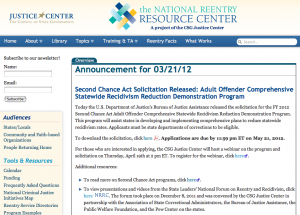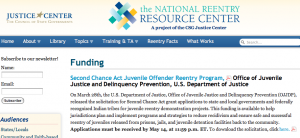Jan 31st/ Jeffrey Tauber
Last January I published an article on the “Ten Reasons to Build a Reentry Court in 2010″. This year I revisit the theme, and rewrite the article from a very different perspective; that of a Reentry Court Judge.
The Reentry Process is nothing new to the Drug Court Practitioner, for the Drug court has always been a reentry mechanism; a seamless process for returning the drug offender from arrest and criminal adjudication , through community-based rehabilitation and monitoring, to the offender’s reintegration into the community. What is different in 2011, is the need to build a Reentry Court for ex-offenders returning from our state prisons; a very different sort of problem-solving court. One modeled on the Drug Court concept, but far different from it; a next-generation problem-solving court, based on the latest research and evidence based practices, and designed to work with high-risk, long-term, institutionalized offenders (and not necessarily serious drug abusers). So rather than adding another layer of bureaucracy to your Drug Court, use your Drug Court resources in a very different way to rehabilitate and reintegrate this new population as it returns to the community. Consider the following reasons to do so:
1. There has been a seismic shift in the nation’s attitude toward imprisonment and prisons. The entire nation seems desperately focused on the prison problem, and its financial and social costs. Conservatives, such as Newt Gingrich are pushing hard for reform that will reduce criminal justice budgets. States are casting about for ways to reduce prison populations, especially the notion of returning the non-violent prisoner back to local jurisdictions to be handled through county jail and community based alternatives (such as Reentry Court). California is just one of at least a dozen states that is moving quickly to make that change, in many cases through the budgetary process.
2. The Drug Court has been tested, evaluated, and analyzed over the past twenty years on an unparalleled scale. The scientific community has concluded that the drug court provides the most effective means to rehabilitate, hold accountable, and reintegrate the “high risk”, non-violent, drug involved offender back into the community. ( Doug Marlowe: A Sober Assessment of Drug Court). The research on Drug Courts gives us reason to believe that the Reentry Court will work as well (or even better than the drug court) with high risk offenders.
3. According to Professor Ed Latessa of the University of Cincinatti, (Dean of reentry research), parolees (normally handled in Reentry Courts) need to be engaged in structured activity for 40 to 70% of their day, and that those programs that address four or more criminogenic needs of the offender do much better than those that don’t. Research suggests that less than 50% of those leaving prison have a serious drug problem, so dealing with substance abuse as the main focus of Reentry Court may not be effective for this population. According to the research, drug abuse is generally not in the first tier of criminogenic needs for the high-risk offender. Dealing with anti-social behaviors, anti-social behavior factors, anti-social cognitions/attitudes, and anti-social peers are generally considered more important treatment needs for the returning offender.
4. The federal government recognizes the success of the Drug Court model, evidenced by their assistance to local jurisdictions and individual courts over the last fifteen years. The federal government must recognize that working with local jurisdictions iss a dead end when it comes to developing Reentry Courts. The federal government needs to work with state governments to make Reentry Courts work. It is clear that counties, traditionally do not have the jurisdiction, resources, or will to tackle the issues of returning state prisoners without extraordinary assistance, and resources from the states.
5. The “Second Chance Act”, and other federal and state initiatives specifically emphasize the need for community-based “task forces”, that work collaboratively in integrating the offender into the community and sharing resources and funding streams to make the process truly a community-wide effort. More than Drug Courts, Reentry Courts need to reach out to the general community, to engage community-wide collaborations in the reintegration of returning offenders into the community.
6. Reentry Courts represent the future of the Problem-Solving Court field; a next generation, comprehensive Collaborative Court that works with “high-risk offenders. The Conference of Chief Justices (CCJ) and the Conference of State Court Administrators (COSCA), have endorsed problem-solving courts based on the “drug court model” on four separate occasions, since 2000, as the lynchpin of future court systems, emphasizing their effectivenesss in dealing with issues such as “recidivism”. (see CCJ Resolution 22/COSCA Resolution 4)
7. Rather than re-inventing the wheel, the nation’s Reentry Reform Movement can take advantage of over two thousand drug courts already in existence. However, rather than adding on to existing drug courts, Reentry Court/Drug Court practitioners need to create minimalist Reentry Courts, (optimally creating stand-alone Reentry Courts) that work for the special needs of the reentering ex-offender.
8. Reentry Courts turn out to be a very different animal than Drug Court. Its population is made up of high-risk offenders, who have been institutionalized for substantial periods of time. Parolees require far more services, incentives, and flexibility than traditional Drug Courts; that creating a community among court staff and participants is critical to parolees who have lost most sense of belonging during long years of imprisonment. A heavy-handed approach to technical violations and minor offenses (including drug abuse) does not work well with this population. Encouragement from the bench, incentives, and the creation of court-based communities provide a far more effective approach. This still requires the active engagement of the parolee in community-based activities (job training, education, volunteer service, substance abuse and cognitive behavioral treatments) from the day they enter the reentry court.
9. Probation or Jail-Based Reentry Courts (sometimes called Pre-entry Courts) represent the simplest solution to prison-overcrowding and reentry issues. The best way to deal with jail-overcrowding and reentry issues, is not to sentence the non-violent, high-risk offenders to prison in the first place, but place those who would otherwise go to prison, under state court and probation jurisdiction, in next-generation, comprehensive Reentry Courts. (see Reentry Court Model)
10. While federal funding for Reentry Court increased substantially last year, it is unlikely that it will increase or even maintain last year’s level of support. State funding for local criminal justice reform, on the other hand, has the potential of being increased extraordinarily as states attempt to reduce prison populations and their costs. Prison-based Reentry Court Systems, such as California’s Six County Parole Reentry Court Pilot Project, are being developed in a number of states. ( Ten Prison-Based Reentry Models ). With an almost zealous intensity, both progressives and conservatives are determined to reduce funding for prison and prisoners, while seemingly intent to increase funding for prison alternatives and local reentry reform. This is an opportunity for Reentry Court advocates that may not come again.



